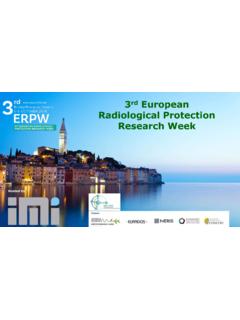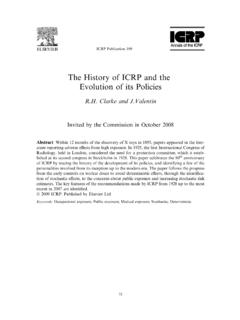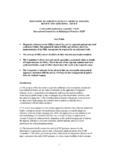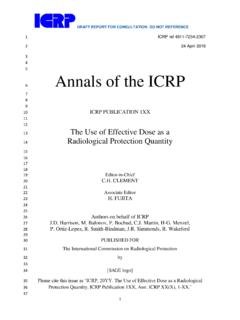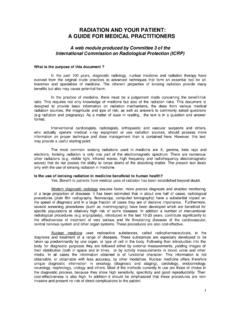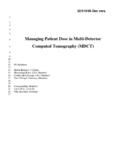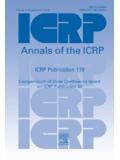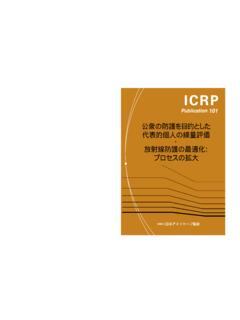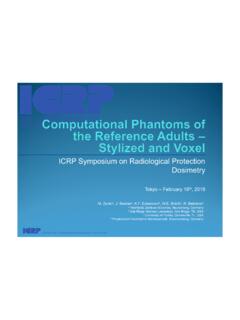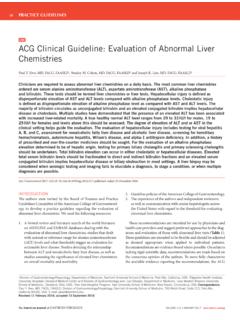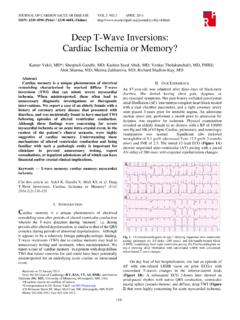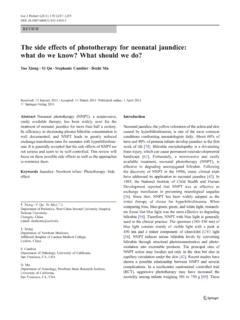Transcription of INTERNATIONAL COMMISSION ON …
1 INTERNATIONAL COMMISSION ON radiological protection April 4, 2011 The INTERNATIONAL COMMISSION on radiological protection (ICRP) in cooperation with Elsevier, the publishers of the Annals of the ICRP, present this special cost-free release of ICRP Publication 111 Application of the COMMISSION s Recommendations to the protection of People Living in Long-term Contaminated Areas after a Nuclear Accident or a Radiation Emergency. ICRP is a registered charity that relies on the sale of publications to help support its ongoing work. However, the cost-free release of this publication is a gesture to aid the Japanese people in recovering from the recent earthquake, tsunami, and accident at the Fukushima Daiichi nuclear power plant.
2 Our thoughts are with those in Japan dealing with the aftermath of these tragic events, and we regret that the recommendations of ICRP Publication 111 need to be put into active use so soon after having been published. This special free release of ICRP Publication 111 is dedicated to those in Japan who have lost so very much. With deep sympathy, on behalf of ICRP, Claire Cousins ICRP Chair Christopher Clement ICRP Scientific Secretary Annals of the ICRPP ublished on behalf of the INTERNATIONAL Commissionon radiological ProtectionAims and ScopeThe INTERNATIONAL COMMISSION on radiological protection (ICRP) is the primary body in protection against ionisingradiation. ICRP is a registered charity and is thus an independent non-governmental organisation created by the1928 INTERNATIONAL Congress of Radiology to advance for the public benefit the science of radiological ICRP provides recommendations and guidance on protection against the risks associated with ionisingradiation, from artificial sources widely used in medicine, general industry and nuclear enterprises, and fromnaturally occurring sources.
3 These reports and recommendations are published approximately four times each yearon behalf of the ICRP as the journalAnnals of the issue provides in-depth coverage of a specific to the journal receive each new report as soon as it appears so that they are kept up to date on the latestdevelopments in this important field. While many subscribers prefer to acquire a complete set of ICRP reports andrecommendations, single issues of the journal are also available separately for those individuals and organizationsneeding a single report covering their own field of interest. Please order through your bookseller, subscription agent,or direct from the is composed of a Main COMMISSION , a Scientific Secretariat, and five standing Committees on: radiationeffects, doses from radiation exposure, protection in medicine, the application of ICRP recommendations, andprotection of the environment.
4 The Main COMMISSION consists of a Chair and twelve other members. Committeestypically comprise 10 15 members. Biologists and medical doctors dominate the current membership; physicists arealso well uses Working Parties to develop ideas and Task Groups to prepare its reports. A Task Group is usuallychaired by an ICRP Committee member and usually contains a number of specialists from outside ICRP. Thus,ICRP is an independent INTERNATIONAL network of specialists in various fields of radiological protection . At any onetime, about one hundred eminent scientists and policy makers are actively involved in the work of ICRP. The TaskGroups are assigned the responsibility for drafting documents on various subjects, which are reviewed and finallyapproved by the Main COMMISSION .
5 These documents are then published as theAnnals of the COMMISSION on radiological ProtectionScientific Clement,ICRP, Ottawa, Ontario, Canada; C. Cousins,Department of Radiology, Addenbrooke s Hospital, Cambridge, UKVice-Chair:Dr. Gonza lez,Argentina Nuclear Regulatory Authority, Buenos Aires, ArgentinaMembers of the 2009 2013 Main COMMISSION of the Boice Jr,Rockville, MD, Cooper,Didcot, UKJ. Lee,Seoul, KoreaJ. Lochard,Fontenay-Aux-Roses, Menzel,Gene`ve, SwitzerlandO. Niwa,Chiba, JapanZ. Pan,Beijing, Pentreath,Cornwall, Preston,ResearchTriangle Park, NC, USAN. Shandala,Moscow, RussiaE. Van o ,Madrid, SpainEmeritus Clarke,Hampshire, UKB. Lindell,Stockholm, Meinhold,Brookhaven, NY, Mettler Jr.
6 ,Albuqverqve, NM, Sinclair,Escondido, CA, USAC. Streffer,Essen, GermanyThe membership of the Task Group during the period of preparation of this report was:J. Lochard (Chair)P. Hedemann-JensenA. Oudiz (2006 2007)I. BogdevitchA. McEwanT. SchneiderE. GallegoA. NisbetP. StrandThe corresponding members were:A. JanssensT. LazoZ. CarrAnnals of the ICRPICRP PUBLICATION 111 Application of the COMMISSION sRecommendations to the Protectionof People Living in Long-termContaminated Areas after a NuclearAccident or a Radiation CLEMENTA uthorsJ. Lochard, I. Bogdevitch, E. Gallego, P. Hedemann-Jensen,A. McEwan, A. Nisbet, A. Oudiz, T. Schneider, P. Strand,Z. Carr, A. Janssens, T. LazoPUBLISHED FORThe INTERNATIONAL COMMISSION on radiological ProtectionbyApplication of the COMMISSION sRecommendations to the Protectionof People Living in Long-termContaminated Areas after a NuclearAccident or a Radiation EmergencyICRP Publication 111 Approved by the COMMISSION in October 2008 Abstract In this report, the COMMISSION provides guidance for the protection of peopleliving in long-term contaminated areas resulting from either a nuclear accident or aradiation emergency.
7 The report considers the effects of such events on the affectedpopulation. This includes the pathways of human exposure, the types of exposed po-pulations, and the characteristics of exposures. Although the focus is on radiationprotection considerations, the report also recognises the complexity of post-accidentsituations, which cannot be managed without addressing all the affected domains ofdaily life, environmental, health, economic, social, psychological, cultural, ethical,political, etc. The report explains how the 2007 Recommendations apply to this type ofexisting exposure situation, including consideration of the justification and optimisationof protection strategies, and the introduction and application of a reference level to drivethe optimisation process.
8 The report also considers practical aspects of the im-plementation of protection strategies, both by authorities and the affected population. Itemphasises the effectiveness of directly involving the affected population and localprofessionals in the management of the situation, and the responsibility of authorities atboth national and local levels to create the conditions and provide the means favouringthe involvement and empowerment of the population. The role of radiation monitoring,health surveillance, and the management of contaminated foodstuffs and other com-modities is described in this perspective. The Annex summarises past experience of long-term contaminated areas resulting from radiation emergencies and nuclear accidents,including radiological criteria followed in carrying out remediation measures.
9 2009 ICRP Published by Elsevier Ltd. All rights :Post-accident; Rehabilitation; Optimisation; Reference level; Stakeholderinvolvement; Radiation monitoring; Health surveillance; Contaminated foodstuffs1 ICRP Publication 111 EditorialAFTER THE issue of the Annals provides advice on the application of the COMMISSION s2007 Recommendations (ICRP, 2008) with respect to existing exposure , it deals with people living in long-term contaminated areas after a nucle-ar accident or radiation emergency, although many aspects of this advice also applyto other instances of existing exposure situations ( radon in dwellings or work-places, naturally occurring radioactive material, or contaminated sites resulting frompast activities).
10 In some ways, this report picks up wherePublication 109 Application of the Com-mission s Recommendations for the protection of people in emergency exposure sit-uations (ICRP, 2009) leaves off, since the situations dealt with in this issue may wellhave evolved from an earlier emergency exposure Task Groups working on these two documents have co-ordinated their effortsso that they give complementary advice of use to radiological protection profession-als in the field of emergency and consequence management. This co-operation wasvital given that an important aspect of the larger problem is the transition froman emergency exposure situation to an existing exposure situation. Strategies mustchange from those driven mainly by urgency, with potentially high levels of exposureand predominantly central decisions, to more decentralised strategies which aim toimprove living conditions and reduce exposures to as low as reasonably achievablegiven the general point that the reader should take from this report is that it emphasisesthe new approach of the COMMISSION which reinforces that the principle of optimi-sation of protection (with some type of restriction on individual doses) is absolutelycentral to the system of protection , and that it is to be applied in a similar way to allexposure situations.
